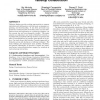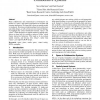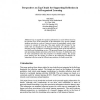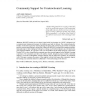969 search results - page 49 / 194 » Designing to support adversarial collaboration |
AVI
2006
13 years 11 months ago
2006
Tabletop displays provide exciting opportunities to support individual and collaborative activities such as planning, organizing, and storyboarding. It has been previously suggest...
CSCW
1996
ACM
14 years 2 months ago
1996
ACM
Many collaborative and communicative environments use notions of "space" and spatial organisation to facilitate and structure interaction. We argue that a focus on spati...
WWW
2007
ACM
14 years 10 months ago
2007
ACM
When authors publish their interpretations of the ideas, opinions, claims or rebuttals in the literature, they are drawing on a repertoire of well understood moves, contributing t...
GI
2009
Springer
14 years 2 months ago
2009
Springer
: Tags are popular for organising information in social software based on the personal views of the participants on the information. Tags provide valuable attention meta-data on a ...
CSCW
1998
ACM
13 years 9 months ago
1998
ACM
MOOSE Crossing is a text-based virtual reality environment (or “MUD”) designed to be a constructionist learning environment for children ages eight to thirteen. The constructio...




